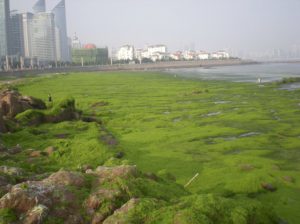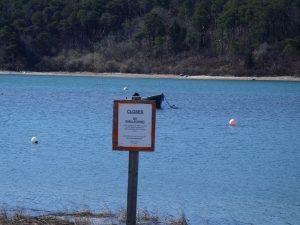Harmful Algal Bloom Symposium 2019: Bringing community needs to the forefront of HAB science
Written by: Alia Hidayat

Green tide in Qingdao, by Dongyan Liu. Photo courtesy of Don Anderson. Copyright © Woods Hole Oceanographic Institution
Last month, I packed my bags and made the trek out of the quickly cooling Northeast to Orange Beach, Alabama. The reason? To nerd out about all things algae at the national Harmful Algal Bloom symposium. It was a week-long deep dive into the current science on harmful algal blooms, from bloom drivers to potential mitigation techniques to impacts on health. In addition to the science, however, what struck me about the conference was the focus on communication with communities beyond academia.
Harmful algal blooms (or HABs) are massive explosions of algae in freshwater and marine environments that have negative consequences for wildlife and humans. What makes HABs such an interesting topic is that – unlike other oceanographic processes which often occur invisibly out at sea – HABs are often very visible (think the massive bloom of Ulva in China during the 2008 Olympics or manatee-killing red tides in the Gulf of Mexico) and can have dramatic effects on communities situated near affected bodies of water. These algal blooms can contribute to declining oxygen conditions or produce deadly toxins which can accumulate in seafood. These can result in massive wildlife die-offs as well as fishery closures to avoid human poisonings.

Pseudo-nitzschia, a marine diatom, produces the toxin domoic acid. Domoic acid and other HAB toxins can accumulate in filter feeders and sicken humans and wildlife when consumed. Illustration by Natalie Renier, originally published in “The recipe for a harmful algal bloom.” Oceanus Magazine, 21 August 2018. Copyright © Woods Hole Oceanographic Institution.
The economic, cultural, and health effects of HABs can be massive. This was emphasized by many of the speakers, including the plenary speaker Dr. Stephanie Moore, who takes a social science approach to assessing the cultural and economic effects of shellfish closures. Using surveys of communities where blooms occur, she showed that HABs can have serious impacts beyond just the direct effect on fishers – when HABs occur, they can have ripple effects on local industries and present a threat to economic security as well as various cultural practices like razor clam harvesting. Given such wide-reaching implications, communicating the science and risks of HABs in order to protect the public presents a major challenge.

“No Shellfishing” sign in Mill Pond, Orleans, MA. Blooms of toxin-producing algae can cause widespread fishery closures. Photo courtesy of Dave Kulis. Copyright © Woods Hole Oceanographic Institution
Why are HABs such a challenge to communicate? Scientifically, they are a complex phenomenon, dependent on many different variables, and are often difficult to predict. To compound the difficulty, they can occur quite suddenly and need an immediate response in order to protect human and animal health. As a result, it can be difficult to give a clear message to the public about what practices are safe and unsafe during a bloom. At the same time, being too alarmist for the sake of safety can also have major consequences.
One infamous algal bloom occurred in 2014, when a massive bloom of microcystins in Lake Erie shut down the water supply of Toledo, Ohio for several days. Over half a million citizens woke up to alerts not to drink, cook with, or (for those with weak immune systems) even touch the tap water, without many other details about what was causing the crisis or how long it would last. As you might expect, this messaging stoked panic from a community suddenly without safe drinking water, and fueled rumors and misinformation. The fear from this event continues today, when many still don’t trust the tap water in Toledo. In another case from 2015, following fishery closures resulting from a massive bloom of Pseudo nitzschia, a major concern of fishermen was that consumers would no longer trust shellfish at all (even when there is no danger of intoxication) and the market would collapse. These fears make clear the importance – but also the risks – in communicating HAB science, and the need for a carefully thought out effort on how to do so responsibly.
Communicating impacts to the public
So, it’s critical to communicate HABs – how do we do this effectively? On the day before the conference, I attended a workshop on communicating HAB science run by Mindy Richlen, Holly Bowers, and Tim Davis. This workshop included a panel of folks involved in communicating HAB science – whether that be working with congress, educational programs, or news outreach. From first-hand experience, they provided some tips on best practices when communicating HABs, though these tips are applicable to science communication in any field:
- Look for opportunities to work with journalists and reporters to reach a broader audience. Whether it be writing op-eds in a journal or reaching out to local reporters with science stories, the panel expressed how local news outlets are often enthusiastic about speaking with scientists and to run news on science stories that affect their community. This is a good opportunity for science messages to gain a wider reach while collaborating with professional communicators.
- Be an advocate for your science in politics. As with any political effort, calling/emailing/visiting your local office is an excellent way to make your voice heard. When you do so, look up what the specific economic impacts of your science are and have clear asks. It’s also prudent to stay abreast of community efforts – if there is a bill that is going up for a vote for science funding in your field, for example, showing a united and collaborative effort from the science community can be very powerful. A good example of this are “Dear Colleague” letters that are written up by members of Congress that we can support as scientists and share with our local representatives.
- Use simple and compelling language. Focus on what people care about and what affects them! The public doesn’t necessarily have to know every scientific principle, just what will help them make empowered decisions in their everyday lives. The panelists recommended sticking to one set of terms and removing jargon from your language as much as possible. One tip they provided was to record yourself answering a question, write up your response, and cross out any unnecessary words from your response. Keeping your descriptions short is especially useful for reporters who are looking for short sound bites. At the same time, be careful to not be pressured into giving misleading or inaccurate messages for the sake of a punchy line.
- Don’t be alarmist. This can be tricky when you’re dealing with a rapidly changing situation like a HAB, but transparency is a must. Stakeholders know the issue very well, and in the words of one of the panelists, “they have a great BS detector” for incorrect messaging or poor management decisions. In order to maintain trust and not to unnecessarily scare people, it is important to be clear about what isn’t affected and what people should not be afraid of. While it’s always good to err on the side of caution, it’s important to realize messaging that overplays the danger can also have significant consequences.
- Admit when you don’t know. Continuing on with the theme of trust, it’s important to recognize when you don’t have the knowledge to answer a specific question. In these situations, it’s good to have a network of other scientists to contact or people who may have the expertise you need. It’s okay to stay in your lane if you’re unsure, and it’s better to defer than to give incorrect information.
Science and public need: a two-way street
At the same time as communicating to the public was important, it’s just as important to communicate with the public. This is critical, as science should not just be something that is communicated to the public after the fact, rather, science should be informed by the needs of the public. So how do we do this? While this is a complex question, I believe the symposium provides a good model for one avenue of communication.
One of the main things we can do as academics is to seek out opportunities to involve stakeholders, regulators, and non-academics in scientific discussions and also make those discussions accessible. Throughout the conference, I found myself talking to almost as many non-academics – whether they be stakeholders, public health officials, government scientists, employees with a tribe, or regulators – as academics. As someone who researches toxicity and human health on a high level, it’s easy to sometimes lose track of what happens after the data gets generated. It was refreshing to be able to speak directly with people who work on the ground doing shellfish testing, talking to community members, etc. in direct support of public needs.
When creating those spaces, we should also be prepared to listen. Later in the week, we had an opportunity to attend a meeting with stakeholders in the shellfishing and tourism industry – for whom HABs aren’t just an academic interest, but a livelihood. What they communicated was a need for real time information on not just when closures might occur, but also how long they might last, in order to inform other choices on alternative fishing, permits, etc. At a separate meeting, public health specialists conveyed the need for communication with the public – and especially the medical community – on how to identify algae as well as symptoms of poisoning in order to respond to a bloom. Other concerns included how exposure to toxins might affect individuals with pre-existing conditions, or who might be exposed to multiple toxins/toxicants simultaneously. These are all examples of really important gaps that science can help fill and the critical need for cross-communication between groups.
Building and maintaining trust
Throughout the conference, the speakers repeatedly talked about the importance of building trust by working with and listening to impacted communities, rather than just handing over regulations in a top-down manner. Algal blooms are complex social and economic problems, and closing down fisheries unnecessarily or without good communication can have devastating effects on fishing communities and erode trust in scientific and governmental organizations. In comparison, working with communities to determine what they need and what scientific gaps should be filled shows that scientists care about the consequences of our science. At the end of the day, scientists, regulators, and stakeholders have the shared interest of understanding and maintaining these natural resources, and have a lot to learn from each other. To conclude, this is a community that cares greatly about doing sound science, but also science that matters and communicating it to the people who are most impacted. Thanks to the efforts of the conference organizers to bring these issues to the forefront, I returned from Alabama energized not just to jump back into research, but to do work that marries science and management for real change.